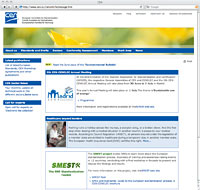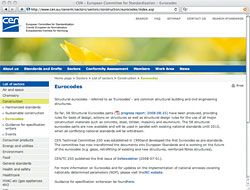Overseas News on Civil Engineering IT
|
|
This section focuses on a unique overseas website related to civil engineering IT. This issue features European Committee for Standardization (CEN: Comite Europeen de Normalisation in French), known for standards and specifications in a wide range including "Eurocodes", the European structural design codes.
Overview of CEN's Activities and Organization
According to its website, CEN's mission is to foster the European economy in global trading, the welfare of European citizens and the environment. A business facilitator in Europe, CEN provides a platform for the development of European Standards and other technical specifications from its standpoint of removing trade barriers for European industry and consumers.
This is based on the idea that standardization reduces trade barriers, promotes safety, allows interoperability of products, systems and services, and improves common technical understanding. Moreover, European Standards are required to realize the Single Market and support the Union's policies for technical integration, protection of the consumer, and encouragement of sustainable development.
CEN's National Members consist of the National Standards Organizations of 30 European countries, including 27 member countries of EU and 3 member countries of the European Free Trade Association (EFTA). On behalf of each country, these members work in cooperation to develop voluntary European standards (ENs). Accordingly, they have voting rights in the General Assembly and Administrative Board of CEN, providing delegations to the Technical Board that defines the work program. On the other hand, the National Members are responsible for implementing European Standards as national standards, to distribute and sell them, and to withdraw any conflicting national standards. Viewing this from a different angle, if a product conforms to the standards, it can reach a far wider market with much lower development and testing cost. It follows that ENs help form a European Internal Market for goods and services and help position Europe in the global economy.
Other than the National Members, Associate Members and Affiliates also take part in the activities of CEN. Associate members consist of broad-based organizations, representing specific sectors of industry as well as consumers, environmentalists, workers, and medium-sized enterprises. With regard to Affiliates, affiliation with CEN is available to a National Standards Body, which is a member of the International Organization for Standardization (ISO) and is the standardization body from an EU neighboring country having links with the EU or EFTA. They are allowed to take part in the General Assembly and in technical bodies.
The website says that more than 60,000 technical experts as well as business federations, consumer and other societal interest organizations are involved in the CEN network.
Here a standard denotes a technical publication used as a rule, guideline, or definition. Standards are created by bringing together all interested parties such as manufacturers, consumers, and regulators of a particular material, product, process, or service. CEN develops standards and other publications on an enormous number of subjects. Formal ENs from CEN have a unique status, for they also are national standards in each of its 30 Member states.
In CEN, there are currently 287 active Technical Committees and 31 active CEN Workshops, with 68 Sub-Committees and 1,401 Working Groups.
CEN has signed a 'Mutual Cooperation agreement with JISC (Japanese Industrial Standards Committee)', to which all questions not strictly related to CEN should be sent.
The Construction Sector and Eurocodes
CEN is a horizontal organization, working in a large number of sectors, in virtually every area that CENELEC and ETSI, which are its partner European Standards Organizations, do not deal with.
To find out the page of "Construction", one can click on 'Sectors' and 'List of Sectors' in the Website.
The page shows an overview that the construction sector represents about 10 % of GDP and 50.5 % of Gross fixed Capital formation, and that it employs more than 12 million EU citizens. It is estimated that 26 million workers in the EU depend on the construction sector in some way.
The construction sector in CEN covers some 3,000 work items on product standards and test methods (for use in building and civil engineering), of which about 500 standards will be harmonized under the Construction Products Directive (CPD) along with about 1,500 supporting standards (test methods).
Under the Construction Sector, the CEN/Technical Committee 250 provides eStructural Eurocodes' for design of structural building and civil engineering structures. The Eurocodes developed so far focus on design aspects related to requirements for mechanical resistance and stability and for safety in case of fire. Up to date the 58 Structural Eurocode parts cover in a comprehensive manner the basis of design, actions on structures, the principal construction materials, such as concrete, steel, timber, masonry, and aluminum, all major field of structural engineering and a wide range of types of structures and products.
Two ghorizontal" Eurocodes are of major importance: Eurocode 7 providing rules for geotechnical design and Eurocode 8 dealing with design of construction works in seismic zones. These 58 structural Eurocodes are currently available and used in parallel with existing national standards until mid 2010, when all conflicting national standards are to be withdrawn. At national level, CEN members have been developing National Annexes covering the National Determined Parameters (NDPs).
The CEN Technical Committee 250 was established in 1990, and developed the first Eurocodes as pre-standards. By the end of 2007 the Committee transformed the documents into European Standards. The objective of further harmonization is to reduce the divergence from the recommended values provided by the Eurocodes. CEN/TC 250 has agreed to work on the development of eurocodes for assessment and retrofitting of existing structures, glass, fibre reinforced polymers, membrane structures and robustness.
 |
 |
|
| (Images provided by CEN) | ||


